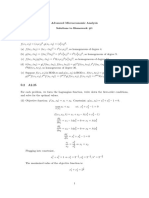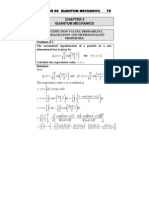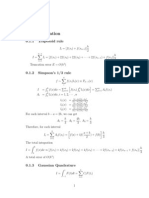Excel Statistics Functions
Uploaded by
s_bis075467Excel Statistics Functions
Uploaded by
s_bis075467EXCEL Probability Distribution Functions
Note: The = before each function name causes EXCEL to use the
function as opposed to simply typing it in as text.
I. Common Discrete Distributions
Binomial Distribution
=BINOMDIST(x,n,p,False) Probability of x successes in n trials with
P(Success)=p
n x p p
x n x
n
p p
x
n
x X P
x n x x n x
,..., 1 , 0 ) 1 (
)! ( !
!
) 1 ( ) (
,
`
.
|
=BINOMDIST(x,n,p,True) Probability of at most x successes in n trials with
P(Success)=p
n x p p
k
n
x p p x X P
x
k
k n k
, , 1 , 0 ) 1 ( ) ( ) 0 ( ) (
0
,
`
.
|
+ +
Geometric/Negative Binomial Distribution
=NEGBINOMDIST(x,r,p) Probability of having x failures prior to the r
th
success
in independent Bernoulli trials with P(Success)=p. This is equivalent to observing
the r
th
success on the (x+r)
th
trial. Geometric distribution arises when r = 1.
,... 2 , 1 ,... 2 , 1 , 0 ) 1 (
1
1
,
`
.
|
+
r x p p
r
r x
x r
Poisson Distribution
=POISSON(x, ,False) Probability of x outcomes when X~Poisson( )
,... 1 , 0
!
) (
x
x
e
x X P
x
=POISSON(x, ,TRUE) Probability of at most x outcomes when X~Poisson( )
,... 1 , 0
!
) (
0
x
k
e
x X P
k x
k
Hypergeometric Distribution
=HYPGEOMDIST(x,n,k,N) Probability of x successes in n Trials in population
with k Successes in N elements
N n x N k x
n
N
x n
k N
x
k
x X P
,
`
.
|
,
`
.
|
,
`
.
|
0 0 ) (
II. Common Continuous Distributions
Exponential Distribution
(Hardly worth the effort. Note: must use reciprocal of mean)
=EXPONDIST(x,1/ ,False) Exponential Density Function
0 0
1
) ; (
/
>
x e x f
x
=EXPONDIST(x,1/ ,TRUE) Exponential Cumulative Distribution Function
/
0
/
1
1
) ( ) ; (
x
x
t
e dt e x X P x F
Gamma Distribution
(Exponential ( 1, ) and Chi-square ( , 2) are
special cases)
=GAMMADIST(x,, ,False) Probability Density Function of Gamma( , )
> >
0
1 / 1
) ( 0 0 0
) (
1
) ( dy e y x e x x f
y x
=GAMMADIST(x,, ,True) Cumulative Distribution Function of
Gamma( , )
0
) (
1
) ( ) (
0
/ 1
x dt e t x X P x F
x
t
t
=GAMMAINV(p, , ) 100p
th
percentile
p X X P
p
) (
( ) 1 0
) (
1
0
/ 1
p dx e x X X P p
p
X
x
p
Normal Distribution
=NORMDIST(x, , , False) Normal density function f(x; , )
( )
0
2
exp
2
1
) , ; (
2
2
2
> < < < <
'
'
x
x
x f
=NORMDIST(x, , , True) Normal cumulative distribution function
) (
0
X X P
( )
( )
,
`
.
|
'
'
x
Z P dt
t
x X P
x
2
2
2
2
exp
2
1
To obtain
) ( x X P
enter: =1-normdist(x, , ,True)
=NORMINV(p, , ) 100p
th
percentile
p X X P
p
) (
( )
( )
p Z Z P Z X dx
x
X X P p
p p p
X
p
p
+
'
'
) (
2
exp
2
1
2
2
2
Function NORMSINV(p) returns the 100p
th
percentile of standard normal (Z)
distribution, that is: NORMSINV(p) = NORMINV(p,0, 1)
Chi-Square Distribution
=CHIDIST(x,v) P(X x) when X~
2
v
(Non integer is truncated)
>
,
`
.
|
x
t
x dt e t x X P 0 0
2
2
1
) (
2 / 1 ) 2 / (
2 /
=CHIINV(p,v) 100(1-p) percentile (Non integer is truncated)
,
`
.
|
P
X
x
p
dx e x X X P p
2 / 1 ) 2 / (
2 /
2
2
1
) (
Beta Distribution
=BETADIST(x, , ) Beta cumulative distribution function (0 x 1)
> >
+
x
x dt t t x X P
0
1 1
0 0 1 0 ) 1 (
) ( ) (
) (
) (
For Beta distributions transformed to the range [A,B], use BETADIST(x, , ,A,B)
=BETAINV(p, , ) 100p
th
-percentile P(X X
p
) = p
+
p
X
p
dx x x X X P p
0
1 1
) 1 (
) ( ) (
) (
) (
For Beta distributions transformed to the range [A,B], use BETADIST(x, , ,A,B)
Lognormal Distribution
If Y = ln(X) ~ Normal(,
2
) then X~Lognormal(,
2
) with:
( ) 1 ) ( ) (
0 , , 0
2
1
) (
2 2 2
2 2
2 2 /
2 / ) ) (ln(
> < < >
+ +
e e X V e X E
x e
x
x f
x
=NORMDIST(ln(x), , ,True) cdf of lognormal distribution: P(Y ln(x)) =
P(X x)
dt e dt e
t
x X P
t
x x
t
2
2
2 2
2
) (
0
) ln(
2 / ) ) (ln(
2
1
2
1
) (
=LOGINV(p, , ) 100p
th
percentile: P(X X
p
) = p
p
X
t
p
dt e
t
X X P p
0
2 / ) ) (ln(
2 2
2
1
) (
Weibull Distribution
=WEIBULL(x,, , False) Weibull probability density function
0 , 0 ) , ; (
) / ( 1
>
x e x x f
x
A second commonly used parameterization is:
/ 1 x
e x
Then use: =WEIBULL(x,,
1/
, FALSE)
=WEIBULL(x,, , True) Weibull cdf
0 , 0 ) , ; (
0
) / ( 1
>
x dt e t x F
x
t
Students t-Distribution (Some documentation in EXCEL is wrong)
=TDIST(x, ,2) 2-sided tail area ( truncated to integer value) for t
distribution
[ ]
1 0 1
) 2 / (
2 / ) 1 (
2 ) ( 1
2 / ) 1 (
2
,
`
.
|
+
+
+
x dt
t
x X x P
x
=TDIST(x, ,1) upper tail area ( truncated to integer value) for t
distribution
[ ]
1 0 1
) 2 / (
2 / ) 1 (
) (
2 / ) 1 (
2
,
`
.
|
+
+
+
x dt
t
x X P
x
=TINV(p, ) 100(1-p)
th
Percentile of t
-distribution (Only meaningful for p<0.5)
[ ]
dt
t
X X P p
p
X
p
2 / ) 1 (
2
1
) 2 / (
2 / ) 1 (
) (
+
,
`
.
|
+
F-Distribution
=FDIST(x,
1
,
2
) Upper tail area for F
1, 2
Distribution (
1
,
2
truncated to
integers)
[ ]
,
`
.
|
+
+
x
x df
f
f x X P 1 , 0 1 ) (
) 2 / ( ) 2 / (
) / ( 2 / ) (
) (
2 1
2 / ) (
2
1 1 ) 2 / (
2 1
2 /
2 1 2 1
2 1
1
1
=FINV(x, ,
1
,
2
) 100(1-p)
th
of F
1, 2
Distribution (
1
,
2
truncated to integers)
[ ]
,
`
.
|
+
+
p
X
p p
X df
f
f X X P p 1 , 0 1 ) (
) 2 / ( ) 2 / (
) / ( 2 / ) (
) (
2 1
2 / ) (
2
1 1 ) 2 / (
2 1
2 /
2 1 2 1
2 1
1
1
You might also like
- Algorithm Optimization For Dynamic Sports Bidding StrategyNo ratings yetAlgorithm Optimization For Dynamic Sports Bidding Strategy3 pages
- How Digital Is Reinventing Levi Strauss & Co.'s IT Business ModelNo ratings yetHow Digital Is Reinventing Levi Strauss & Co.'s IT Business Model5 pages
- A Report On The Channel Analysis in An FMCG Company - NestleNo ratings yetA Report On The Channel Analysis in An FMCG Company - Nestle37 pages
- Astrazeneca - Operations: Friday, 17 October 2003 Barrie Thorpe - Executive Vice President OperationsNo ratings yetAstrazeneca - Operations: Friday, 17 October 2003 Barrie Thorpe - Executive Vice President Operations52 pages
- Designing and Managing Value Networks and Channels100% (1)Designing and Managing Value Networks and Channels22 pages
- Analysis of Retailer's Coping Style After Epidemic - Based On IKEA's Coping StyleNo ratings yetAnalysis of Retailer's Coping Style After Epidemic - Based On IKEA's Coping Style8 pages
- Michael Porter - New Global Strategies For Competitive Advantage PDFNo ratings yetMichael Porter - New Global Strategies For Competitive Advantage PDF11 pages
- Problems by Jim Pitman. Solutions by George ChenNo ratings yetProblems by Jim Pitman. Solutions by George Chen8 pages
- Bayesian Decision Theory: Prof. Richard ZanibbiNo ratings yetBayesian Decision Theory: Prof. Richard Zanibbi47 pages
- Linearization Stability Definitions Simulation in Matlab/SimulinkNo ratings yetLinearization Stability Definitions Simulation in Matlab/Simulink39 pages
- Informationtheory-Lecture Slides-A1 Solutions 5037558613No ratings yetInformationtheory-Lecture Slides-A1 Solutions 50375586130 pages
- Random Variables: BY T. Nandana Jyothi Asst. Prof, Dept of EEE K L UniversityNo ratings yetRandom Variables: BY T. Nandana Jyothi Asst. Prof, Dept of EEE K L University10 pages
- Background For Lesson 5: 1 Cumulative Distribution FunctionNo ratings yetBackground For Lesson 5: 1 Cumulative Distribution Function5 pages
- Sangap - Solusi (6,13,20,27,34,41,48,55)No ratings yetSangap - Solusi (6,13,20,27,34,41,48,55)9 pages
- Optimal Control (Course Code: 191561620)No ratings yetOptimal Control (Course Code: 191561620)4 pages
- Expectation: Definition Expected Value of A Random Variable X Is DefinedNo ratings yetExpectation: Definition Expected Value of A Random Variable X Is Defined15 pages
- Formula Sheet (1) Descriptive Statistics: Quartiles (n+1) /4 (n+1) /2 (The Median) 3 (n+1) /4No ratings yetFormula Sheet (1) Descriptive Statistics: Quartiles (n+1) /4 (n+1) /2 (The Median) 3 (n+1) /413 pages
- Multivariable Calculus, 2008-10-31. Per-Sverre Svendsen, Tel.035 - 167 615/0709 - 398 526No ratings yetMultivariable Calculus, 2008-10-31. Per-Sverre Svendsen, Tel.035 - 167 615/0709 - 398 5265 pages
- The Exponential Family of Distributions: P (X) H (X) eNo ratings yetThe Exponential Family of Distributions: P (X) H (X) e13 pages
- The Binomial Probability Distribution PDFNo ratings yetThe Binomial Probability Distribution PDF7 pages
- Calculation of Skewness and Kurtosis using Pearson’s Beta and Gamma CoefficientsNo ratings yetCalculation of Skewness and Kurtosis using Pearson’s Beta and Gamma Coefficients21 pages
- Digital Communication KEC-601 ST-1 QP Even 21-22No ratings yetDigital Communication KEC-601 ST-1 QP Even 21-222 pages
- Statistics & Probability Practice Test 3No ratings yetStatistics & Probability Practice Test 33 pages
- 6.1: Discrete and Continuous Random VariablesNo ratings yet6.1: Discrete and Continuous Random Variables24 pages
- Ujian Tengah Semester 1 Biostatistika Magister Kesehatan MasyarakatNo ratings yetUjian Tengah Semester 1 Biostatistika Magister Kesehatan Masyarakat2 pages
- Constructing A Probability Histogram A Continues Random VariableNo ratings yetConstructing A Probability Histogram A Continues Random Variable23 pages
- Statistics Syllabus by Telangana UniversityNo ratings yetStatistics Syllabus by Telangana University8 pages
- Buhlmann Credibility Homework SolutionsNo ratings yetBuhlmann Credibility Homework Solutions11 pages
- Algorithm Optimization For Dynamic Sports Bidding StrategyAlgorithm Optimization For Dynamic Sports Bidding Strategy
- How Digital Is Reinventing Levi Strauss & Co.'s IT Business ModelHow Digital Is Reinventing Levi Strauss & Co.'s IT Business Model
- A Report On The Channel Analysis in An FMCG Company - NestleA Report On The Channel Analysis in An FMCG Company - Nestle
- Astrazeneca - Operations: Friday, 17 October 2003 Barrie Thorpe - Executive Vice President OperationsAstrazeneca - Operations: Friday, 17 October 2003 Barrie Thorpe - Executive Vice President Operations
- Designing and Managing Value Networks and ChannelsDesigning and Managing Value Networks and Channels
- Analysis of Retailer's Coping Style After Epidemic - Based On IKEA's Coping StyleAnalysis of Retailer's Coping Style After Epidemic - Based On IKEA's Coping Style
- Michael Porter - New Global Strategies For Competitive Advantage PDFMichael Porter - New Global Strategies For Competitive Advantage PDF
- Linearization Stability Definitions Simulation in Matlab/SimulinkLinearization Stability Definitions Simulation in Matlab/Simulink
- Informationtheory-Lecture Slides-A1 Solutions 5037558613Informationtheory-Lecture Slides-A1 Solutions 5037558613
- Random Variables: BY T. Nandana Jyothi Asst. Prof, Dept of EEE K L UniversityRandom Variables: BY T. Nandana Jyothi Asst. Prof, Dept of EEE K L University
- Background For Lesson 5: 1 Cumulative Distribution FunctionBackground For Lesson 5: 1 Cumulative Distribution Function
- Expectation: Definition Expected Value of A Random Variable X Is DefinedExpectation: Definition Expected Value of A Random Variable X Is Defined
- Formula Sheet (1) Descriptive Statistics: Quartiles (n+1) /4 (n+1) /2 (The Median) 3 (n+1) /4Formula Sheet (1) Descriptive Statistics: Quartiles (n+1) /4 (n+1) /2 (The Median) 3 (n+1) /4
- Multivariable Calculus, 2008-10-31. Per-Sverre Svendsen, Tel.035 - 167 615/0709 - 398 526Multivariable Calculus, 2008-10-31. Per-Sverre Svendsen, Tel.035 - 167 615/0709 - 398 526
- The Exponential Family of Distributions: P (X) H (X) eThe Exponential Family of Distributions: P (X) H (X) e
- Calculation of Skewness and Kurtosis using Pearson’s Beta and Gamma CoefficientsCalculation of Skewness and Kurtosis using Pearson’s Beta and Gamma Coefficients
- Ujian Tengah Semester 1 Biostatistika Magister Kesehatan MasyarakatUjian Tengah Semester 1 Biostatistika Magister Kesehatan Masyarakat
- Constructing A Probability Histogram A Continues Random VariableConstructing A Probability Histogram A Continues Random Variable

























































































